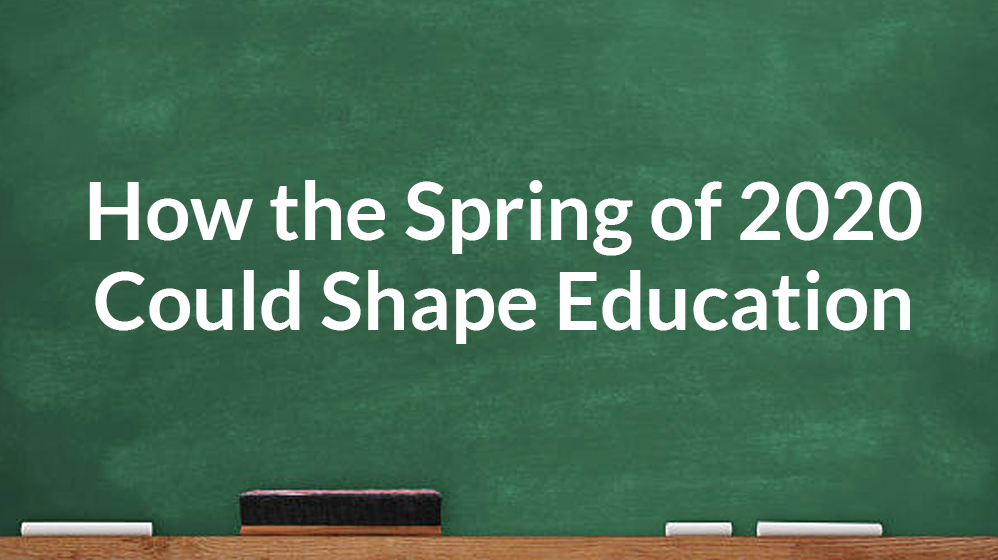I have been taking a lot of time to really think and sit with what has been going on in the world this past spring. I’ve had highs, I’ve had lows, I’ve had “aha” moments, and I’ve made many shifts in my thinking, particularly about how we provide meaningful and equitable educational experiences for all students. But one thing remains the same; I am continually brought back to thinking about the classroom and the tremendous responsibility we have as educators to not only learn from these experiences, but to take action in our own classrooms, our schools, and our districts. Furthermore, I am reminded of how lucky we are to be in such a position where the current situation can propel us forward as teachers to make positive changes in our own classrooms instantly. This is not a role I take lightly, and I am hoping collectively we can make some great and lasting shifts for the better. I am nowhere near having all the answers, nor should I be, but these are some particular areas that I would encourage us all to think deeply about, start conversations around, and take steps to make shifts in our own practices and curriculum.
Explicit Instruction, Mastery, and Student Ownership
If one thing has become abundantly clear in the past three months, it is that we need to become crystal clear about what we’re teaching and how we know when students have mastered it. Clear learning targets have always been an essential part of all curriculum planning, but how has that translated into our daily lesson planning? How often are we referring students back to the target? How often are we getting students to reflect, self-assess, and goal set based off of targets? And how often are students self-directing their own learning?

As we transitioned into e-learning, I saw a dramatic shift in teachers becoming more explicit about exactly what they wanted students to master in their curriculum. Virtual lessons were focused on very clear learning targets, and independent practice was set aside for students to work towards mastering these set targets. This process allowed students to be very clear about what they are learning and as a result, actually be able to better gauge when they had hit mastery.
Though this is a step in the right direction, I think we have the tremendous opportunity to take this learning experience further, where students are not only clear on what they are learning, but they are also taking ownership in their learning process. Through numerous conversations with colleagues, it became evident very quickly which students had the skills to be independent and resourceful in their work, and which students did not. In one particular conversation, a teacher said to me that she really needed to stop holding students’ hands throughout every step of learning in the classroom, and I could not have agreed more. Is it not our role as educators to help students not only master the curriculum, but build the necessary life skills to be successful outside of school? If anything has become clearer these past three months, it is that students need to also learn how to collaborate, problem-solve, and work independently. Students should be tracking their own progress toward mastering learning targets, students should be self-assessing their own mastery throughout a lesson, and students can be identifying not only their own goals for learning, but identifying the roadblocks they encounter and how they will overcome them. As a result, our role in the classroom naturally becomes one where we guide learning and help students build a repertoire of tools and skills to be independent, critical learners, rather than students who are just “consuming” information. Additionally, this gives us a clear understanding of where students are in their learning, and it helps us identify the necessary supports for students, whether for the purpose of enrichment and deepening learning or providing more scaffolding and/or pre-teaching.
How often do we invite students to be part of the conversation on what mastery looks like? We can create learning opportunities where students develop their own criteria for mastery collectively. As we know, when students take ownership in their learning process, not only are they more motivated to learn, but they become very clear on how to be successful. And when students are clear on what success looks like, mastery does not look as daunting. This concept is not as hard as it may sound. Can we have students look at exemplar examples of work and then identify what made them successful? Can we have students dive into some of their own research to identify what criteria equals mastery? The answer is, yes, we can. And we should. Again, this experience has made me really reflect on what our true role is as an educator in the classroom. If we are only ever focused on delivering content, we are missing an opportunity to really have students take a leadership role in their own learning. And, is this not what we want? If we can teach students to be independent and critical thinkers in their learning, then, they can learn anything they ever dream of.
Learning for All
If you’re like me, the last three months have really made me take a hard look at the curriculum we already have in place. And, it has forced me to ask myself some hard questions. I’ve prided myself on always welcoming diverse voices into my classroom and making sure learning was equitable for all, but these past three months made me really ask myself: Is our curriculum really equitable for all? Right away, it is easy for use to get defensive and say, yes, I care about all of my learners and always have; yes, I always make sure learning is equitable; yes, my unit plans are already really good, so why change them? But, these past few months made me realize that if our students, our families, our neighborhoods, and our country are always changing, then, why are we not willing to change our curriculum? We have an obligation as educators to question old practices and ask ourselves: does our curriculum still serve all? It does not mean that our old curriculum was bad; it just means we need to change with the times. It would be like going to the doctor and her or him saying to us there’s a new medication out there that could help you, but I really like this old one, so I’m going to give you that. We would look at our doctor like they were crazy. We are obligated to do what’s best for our students, so therefore, we have the duty to make sure our curriculum is always improving.
Differentiation is a buzz word that every single one of us has heard in education over and over and over again. When teachers hear the word differentiation, I can immediately see eyes glaze over. But I started to think: are we actually, truly differentiating our instruction for students? As an instructional coach, I work with middle school teachers in every grade level and content. Coaching cycles are optional, and teachers are not only allowed to choose what they would like to work on with me, but we also allow choice in professional development and goal setting, because we honor our teachers as professionals. We know as educators that we all have different things we need to work on, and we have different ways we learn and work. But, why do we sometimes have a hard time implementing this same concept in the classroom with our students? Don’t get me wrong. Differentiation. Is. Hard. The idea that every student may need something different, and we have only 40 minutes to do so feels incredibly daunting. But, what about that student in our class who isn’t connecting with what we are reading? What about that student in class who really benefits from working with you one-on-one or in a small group? What about that student in class who just doesn’t see the point? I’m certain that I’m preaching to the choir here, but I think we need to really take a hard look at how we are actually differentiating for students. And, I think it starts by simply questioning the practices we already have in place. Is our curriculum serving all of our students? Is our diverse student body represented in our curriculum? Do we encourage differing viewpoints and perspectives? Do we provide choice in our curriculum and lessons that are tied to students’ current reality? Do we set enough time aside where students can practice on their own, confer with us, and learn from each other?
As always, I ask these questions not having all of the answers, but one thing is clear: we need to continually be revamping our curriculum and unit plans, because our students and our world are continually changing in front of us. And, this is a process; it is not something we check off a list. This fall, let’s take the opportunity to have these conversations in our department meetings, in our staff meetings, in our planning meetings. Collaboration always makes us stronger, and we owe it to our students.

Transferable Skills
The last area I have been thinking a lot about is what are the true skills that our students are going to need to be successful in life. I know this could open a can of worms as we argue which skills are most essential, but how often do we stop ourselves to actually ask WHY we are teaching what we’re teaching? If the only response we can come up with is that students will need to know this for the test, the next unit, or the next grade level, then I really think we need to question what we’re teaching. What do our students really need to be successful? I am continually reminded that we have an obligation to teach to our standards, but what about knowing how to collaborate? What about how to be a critical thinker? Especially with the vast amount of information our students are bombarded with every single day. What about how to problem-solve, read, write, speak, and listen? I think we would all agree that these are the skills students are really going to need to be successful, but we are tied to our standards and curriculum. So, how do we integrate these important life skills with our curriculum? The most important thing we can teach our students are the skills they will be able to transfer to multiple parts of their lives, not just the memorization of facts and content. Not only does this make learning more meaningful and purposeful for students, but these are skills that they will actually be able to take with them wherever they go. Again, I am not here to sit and tell you which skills are most important, but this should be a question we are continually asking ourselves. We need to be critical about our curriculum and teaching, just as we ask students to be critical thinkers themselves.
One of the most important things we can do as educators is to constantly question our practices. Start the conversations with your colleagues, your administrators, and your students. Let’s collectively debate, discuss, and shift our practices. Let’s get more reflective in our own practices and seek improvements in our curriculum. And most importantly, let’s put those changes into practice and then change again. If we want students to learn, grow, and reflect, we need to first start by modeling these practices ourselves.
Educators, how are you adjusting your practice in our new normal?
Feel free to share in our comments section.






